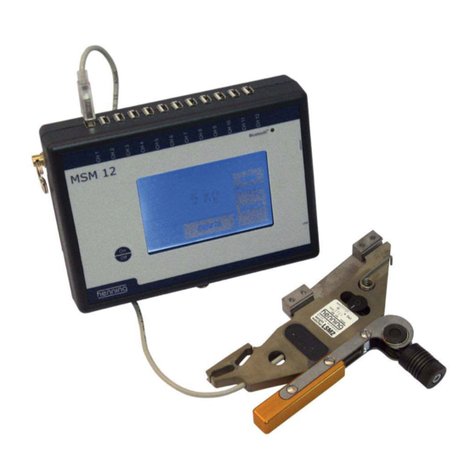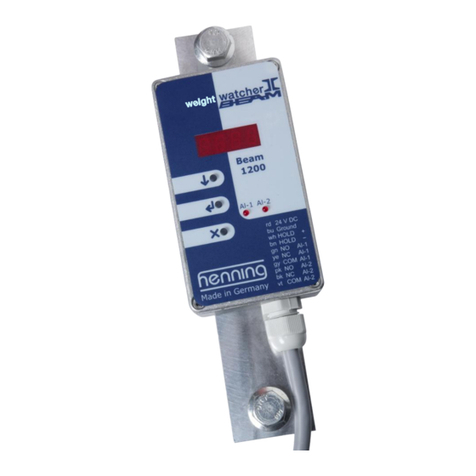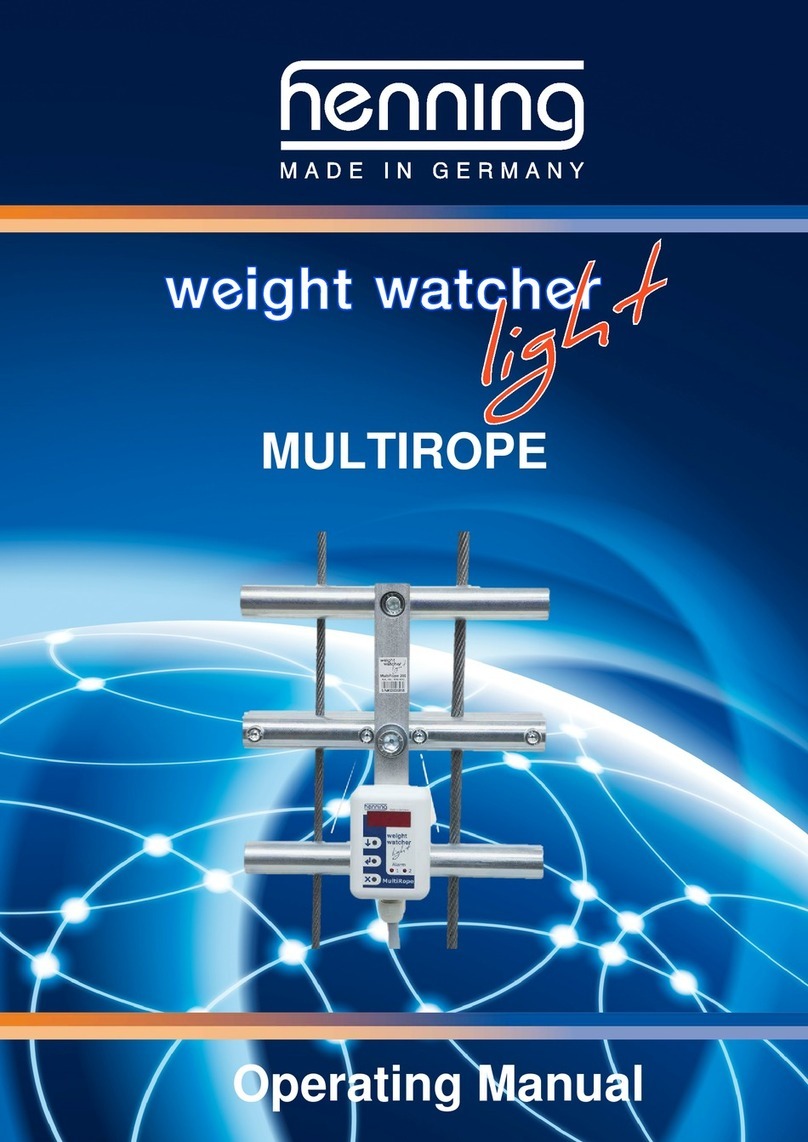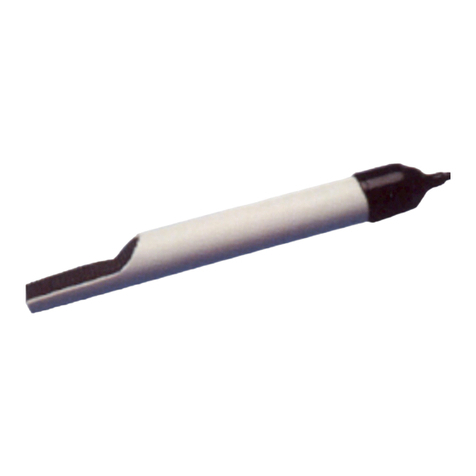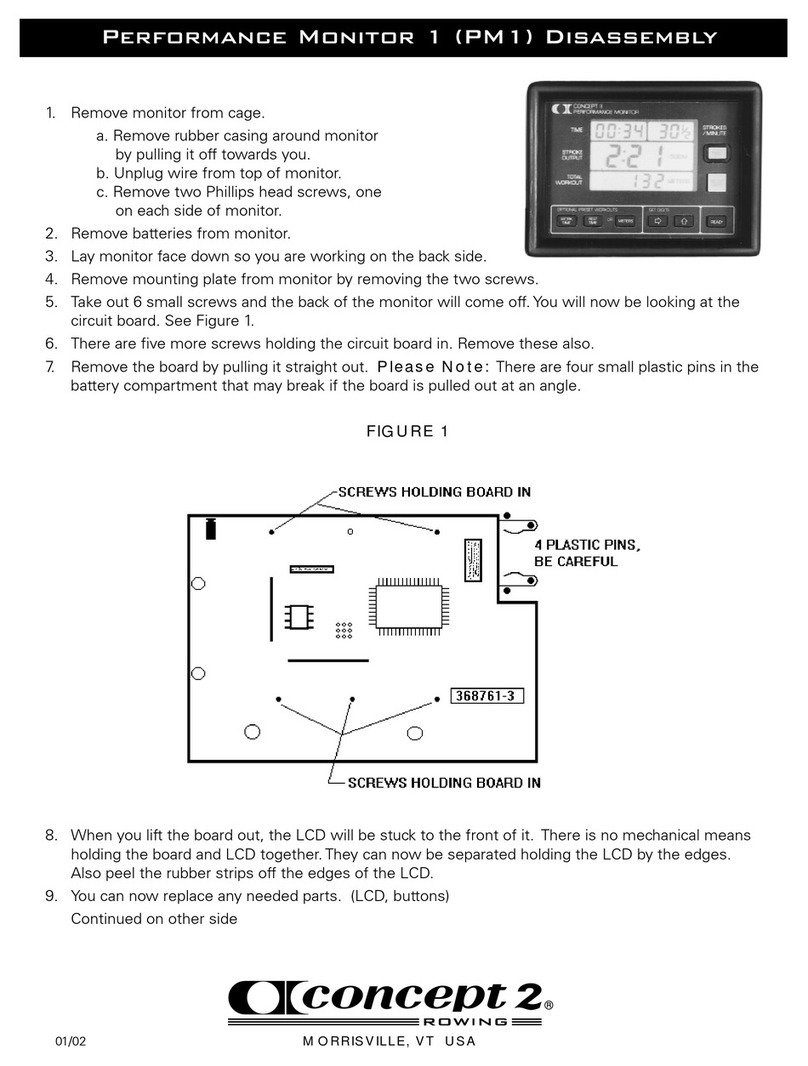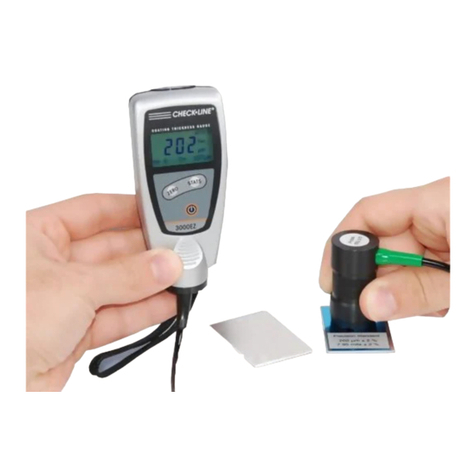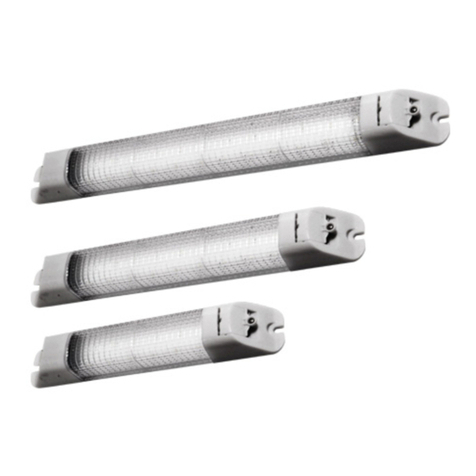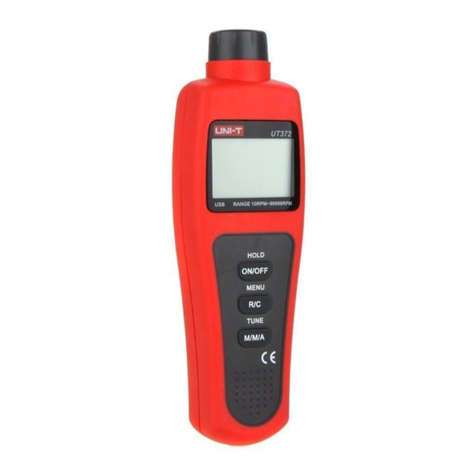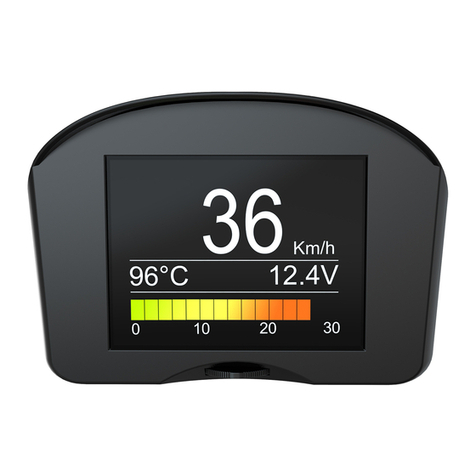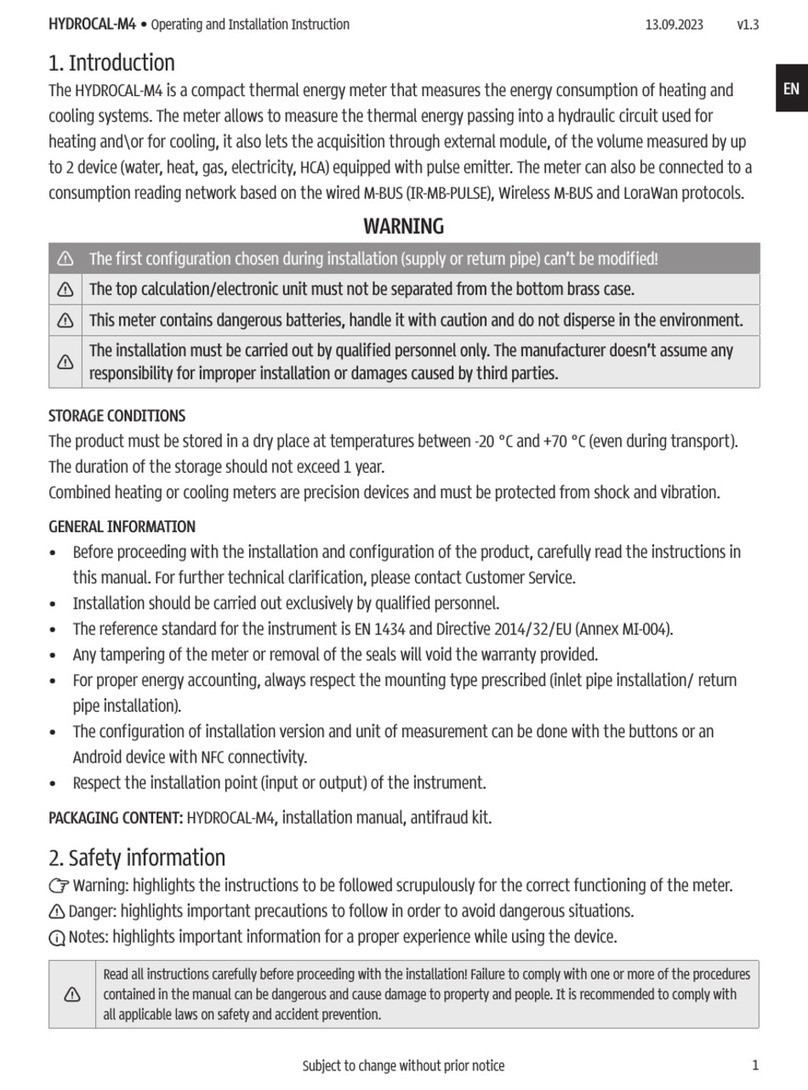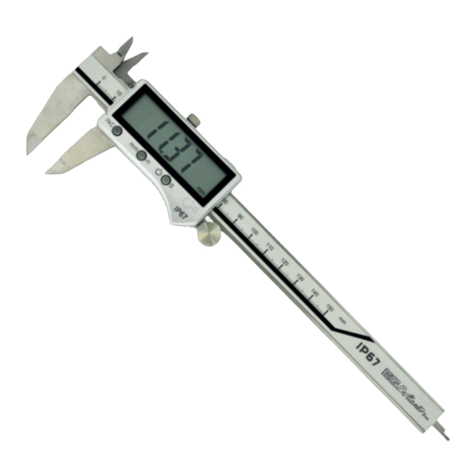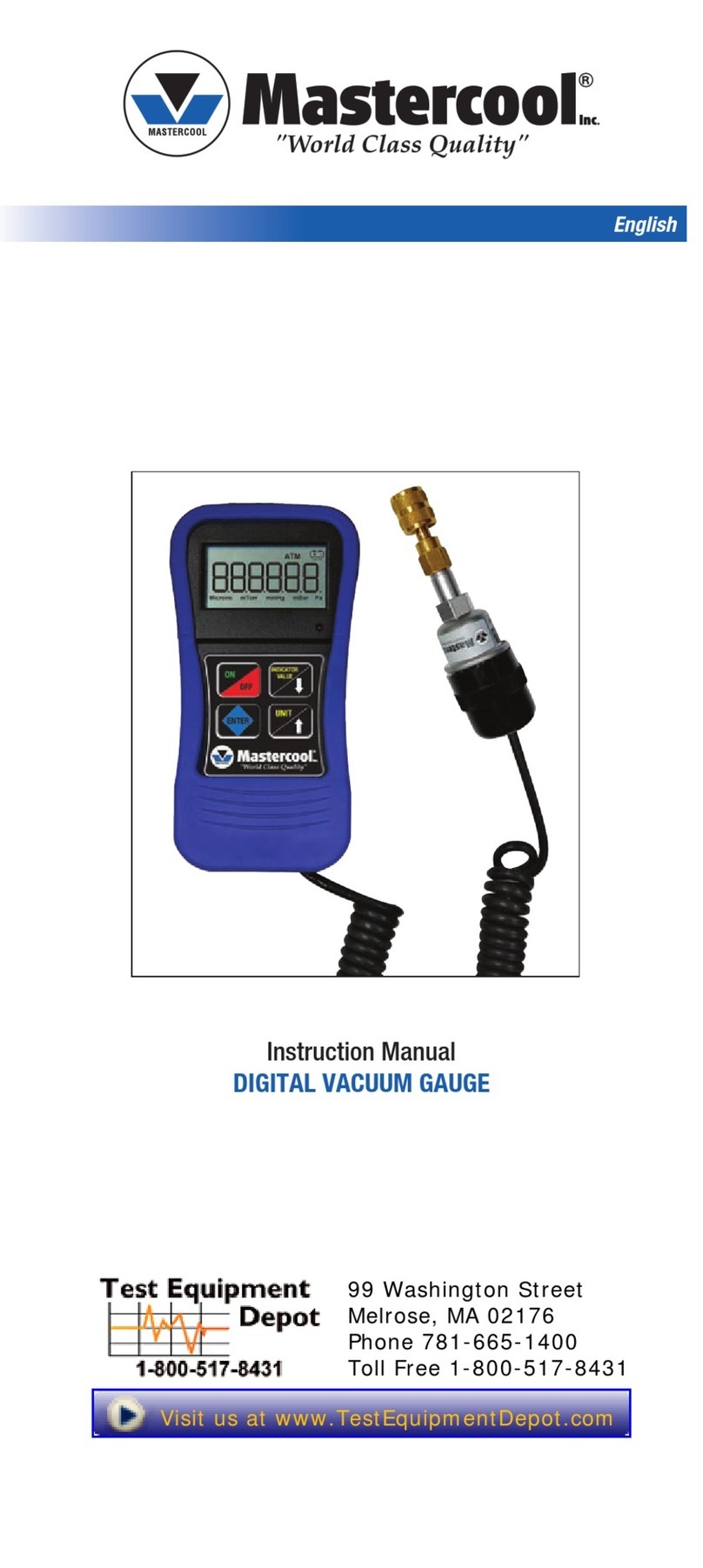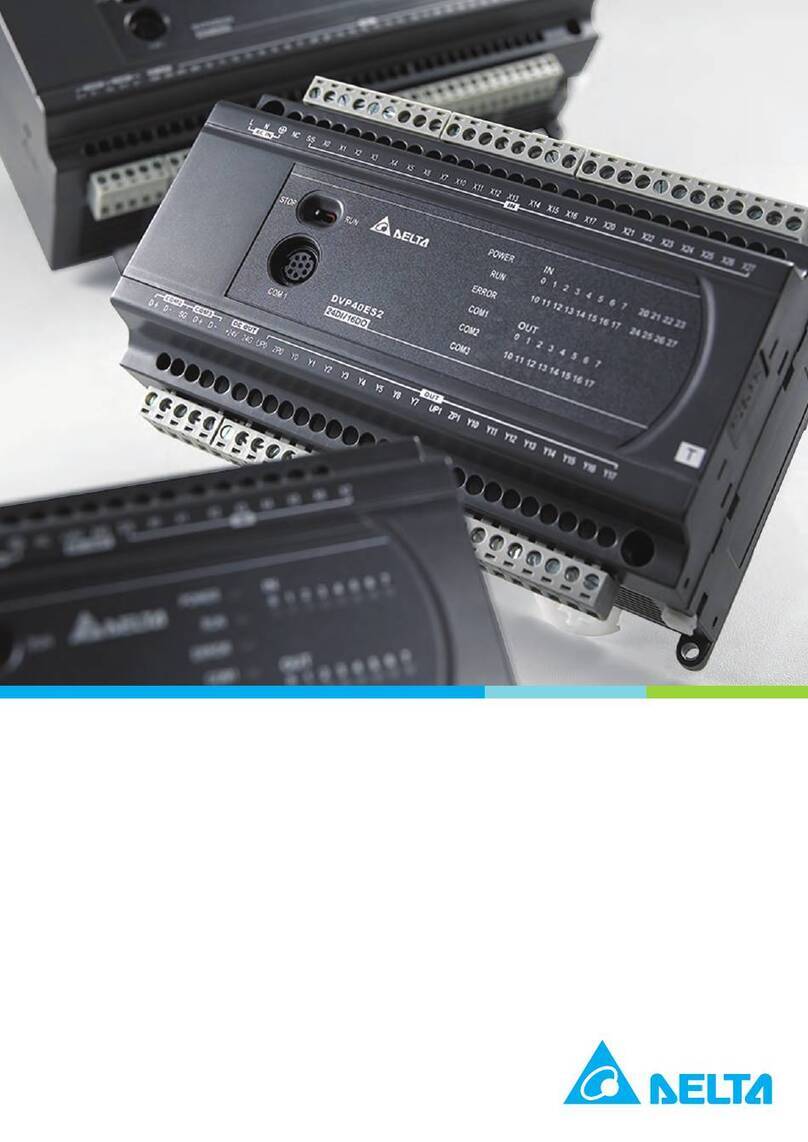HENNING AE16 Light User manual

Operating Manual
Evaluation Unit AE16 Light
and
Rope Load Sensor LS-Light
Service-Hotline: +49 2336 9298-232

©Copyright 2011 by Henning GmbH & Co. KG
Rev. 1.2 10/2011
2
Table Of Contents
1. Dimensions.............................................................................................3
2. Connection Diagram...............................................................................4
3. Alarm Relays..........................................................................................5
4. HOLD-Function ......................................................................................5
5. How to Access a Parameter...................................................................5
6. How to Adjust a Parameter ....................................................................6
7. Scheme of Menu....................................................................................7
8. How to Adjust the Number of Rope Sensors..........................................8
9. How to Calibrate the Load Measuring....................................................8
10. Alarm Limits........................................................................................10
11. How to Adjust the Analogue Output (Option) .....................................11
12. How to Adjust the Display ..................................................................11
13. Electric Characteristics.......................................................................12
14. Fault Messages..................................................................................12
15. How to Install Rope Load Sensors LS-light........................................13
16. Operation Instructions in Brief............................................................15

©Copyright 2011 by Henning GmbH & Co. KG
Rev. 1.2 10/2011 3
1. Dimensions
Measuring Channels 1 to 16
Power Supply
+-
HOLD-Input
-
+ Analogue
Output
(optional)
+-
AL-1 AL-3
AL-2

©Copyright 2011 by Henning GmbH & Co. KG
Rev. 1.2 10/2011
4
2. Connection Diagram

©Copyright 2011 by Henning GmbH & Co. KG
Rev. 1.2 10/2011 5
3. Alarm Relays
AL-1 (change-over contact)
Changes state as soon as the load limit adjusted by AL-1 is exceeded.
AL-2 (change-over contact)
Changes state as soon as the load limit adjusted by AL-2 is exceeded.
AL-O (change-over contact)
Changes state as soon as the load limit adjusted by AL-3 is exceeded.
4. HOLD-Function
The HOLD-input responds to alternating and direct voltages between 12V and 230V.
Due to friction at the guide rails etc., loads measured during travelling might heavily
fluctuate. This will prevent the alarm from putting out any alarm as long as the HOLD-
input is supplied with voltage (e.g. travelling signal).
5. How to Access a Parameter
Weightwatcher light is provided with a menu offering access to the adjustable
parameters.
This key is pressed to browse through the menu items. After selecting a menu
item, it is used to navigate through the sub-menu. For parameters, it helps you set the
parameter-value desired.
This key is pressed to select a menu item displayed, or to apply the value set for a
parameter.
This key is pressed to quit the current menu item or parameter without applying
the set value. By repeatedly pressing this button, you will return to displaying the
current total load in the car.

©Copyright 2011 by Henning GmbH & Co. KG
Rev. 1.2 10/2011
6
Attention:
Weightwatcher light AE16 automatically returns to its home-position displaying the
current total load in the car, and will do that after one minute without any push of a
button, regardless of which menu-item had been selected beforehand.
After ten minutes without any push of a button it changes into the energy-saving mode,
i.e. the display goes off for being reactivated by the next push of a button.
6. How to Adjust a Parameter
1.) Press button to navigate through the parameters until the one to be
adjusted is displayed.
2.) Press button to select this parameter.
3.) Press button to navigate to the value desired for the currently flashing digit.
Press button to change to the next digit.
4.) After setting the last digit, press button again. After that the whole figure will
be flashing.
5.) Press button once more to apply the adjusted parameter.

©Copyright 2011 by Henning GmbH & Co. KG
Rev. 1.2 10/2011 7
7. Scheme of Menu
01876 current total load
(5 digits in the menu-item selected)
rCnt number of ropes/rope-sensors
(rope count)
CaLib calibrating of rope-sensors
(calib)
tara zero point adjustment
(tara)
ALARm state-changing thresholds of alarm-relays
(alarm)
dCovt analogue output
(DC-out) (relevant only for AE16light with option: analogue output)
Units weight unit
(units)
P 100 version number
(Programm-Version)

©Copyright 2011 by Henning GmbH & Co. KG
Rev. 1.2 10/2011
8
8. How to Adjust the Number of Rope Sensors
a) By navigate to menu-item rCnt (rope count) and select it
by pressing .
b) Follow the instructions of item 6 „How To Adjust A Parameter“ and adjust the
correct number of rope-sensors.
c) It is possible at any time to quit this menu-item by pressing .
Attention:
It is inevitable to adjust the true number of rope-sensors as otherwise AE16 light would
trace missing sensors and switch to the error-mode by activating all alarm-relays.
9. How to Calibrate the Load Measuring
Leaving the pre-adjusted menu-item Units unchanged means that the loads
are to be entered in terms of percent of the nominal load, such as for example
100% for full load and 105% for overload.
Take the following steps to calibrate the evaluation unit of WeightWatcher light:
1. Mount the rope-sensors LS-light to the ropes.
2. Connect sensors to evaluation unit AE16light
3. Connect AE16light to a power supply ranging between 12V and 28V DC
4. Calibrate the evaluation unit AE16 both under full load and zero-load conditions.
a. How to Calibrate Zero Load
Purpose of this function is to compensate the weight of the empty cabin.
Take the following steps:
i. By navigate to menu-item CALib and select it by pressing
. Then navigate by to menu-item ZEroC and select it
by pressing . The standard value (refer to Units) is
000*o (0% load, i.e. empty cabin). As soon as you will have
adjusted the last digit, the whole figure will be flashing.

©Copyright 2011 by Henning GmbH & Co. KG
Rev. 1.2 10/2011 9
ii. Apply it by pressing . After that a countdown will be running
from 99999 to 00000. At 00000 the current weight of the
car will be measured. It goes without saying that at that moment
there must not be anything in the cabin or on the car roof that
does not belong there under normal operation conditions (tools!),
and that there must not stay any person in the cabin or on the car
roof in order not to warp the zero load parameter.
b. How to Adjust Full load
Take the following steps:
i. By navigate to menu-item CALib and select it by pressing
. Then navigate by to menu-item LoadC and select it
by pressing . After that adjust on the display an arbitrary load
to be loaded into the cabin. Unless you changed the standard of
menu-item Units enter this load in terms of a percentage of the
nominal load, i.e. 100% (100*o), if you are loading the nominal
load, or 75% (075*o) if you are going to load ¾ of the nominal
load only. As soon as you will have adjusted the last digit, the
whole figure will be flashing.
ii. Apply it by pressing . After that a countdown will be running
from 99999 to 00000. At 00000 the current weight of the
car including load will be measured. It goes without saying that at
that moment there must not be anything additional in the cabin or
on the car that does not belong there under normal operation
conditions (tools!), and that there must not stay any person in the
cabin or on the car roof in order not to warp the full load
parameter.
iii. As from now on calibration of the rope-sensors is completed and
in effect.

©Copyright 2011 by Henning GmbH & Co. KG
Rev. 1.2 10/2011
10
10. Alarm Limits
Alarm limit: a designation that corresponds to the load limit in the cabin, which – if
exceeded – will change the state of the alarm relay. After changing the state of the
alarm-relay, the corresponding status-LED will be luminating.
AL-1 (freely programmable load)
Changes its state, if the load limit adjusted by parameter AL-1 is exceeded.
AL-2 (freely programmable load)
Changes its state, if the load limit adjusted by parameter AL-2 is exceeded.
AL-3 (freely programmable load)
Changes its state, if the load limit adjusted by parameter AL-3 is exceeded.
How to Adjust the Alarm Limits:
1. By navigate to menu-item ALArm and then press .
2. Now – in the same manner – navigate to the alarm limit to be adjusted (AL-1,
AL-2 or AL-3) and select it by pressing .
3. By navigate to the desired value of the currently flashing digit and select it
by pressing . This will at the same time make the next digit flash.
4. After having adjusted the last digit and accordingly pressed , the whole
figure will be flashing.
5. Press once more to apply the parameter.
6. You can quit this menu-item at any time by pressing .
Attention:
Unless you changed the standard setting of menu-item Units, the alarm
limits are to be adjusted in terms of percentage, i.e. 100% for full load and 105%
for overload.

©Copyright 2011 by Henning GmbH & Co. KG
Rev. 1.2 10/2011 11
11. How to Adjust the Analogue Output (Option)
Parameter dCovt is meant to adjust the weight the analogue output shall provide
the maximum output value of 20 mA for. This menu-item consists of two sub-items to
be adjusted separately:
- By parameter LoAd the load is to be adjusted, the analogue output shall
provide the maximum output value (20 mA) for.
- Parameter oFFS serves for switching a Live Zero on resp. off.
- Ajusting this option to on means that 0 kg rope-load measured corresponds to
an analogue output signal of 4 mA.
Switching this option off by oFF means that 0 kg rope-load measured
corresponds to an analogue output signal of 0 mA.
12. How to Adjust the Display
Menu-item Units offers two options. Weights and alarm limits will be displayed
according to the option you choose.
- Prcnt (Percentage) Weights are all displayed in terms of percentage.
(preset standard)
Full load equals 100%
Empty cabin equals 0%
LoAd (Load) Weights are displayed in terms of load. No need to
set a measuring unit.

©Copyright 2011 by Henning GmbH & Co. KG
Rev. 1.2 10/2011
12
13. Electric Characteristics
Evaluation Unit AE16light
Supply Voltage 12 V – 28 V DC
Power Consumption < 0,8 W
Fuse 1 A mT
HOLD-Input 12V-230 V AC/DC
Relay outputs 3
max. switching voltage 250 V AC / 220 V DC
max. starting current 2 A
max. continuous load current 30 V DC 1 A
125 V AC 0,3 A
max. switching capacity
(resistive load) 62,5 VA
max. switching capacity
(inductive load) 62,5 VA
min. switching load DC 10 mV DC 0,01 mA
Analogue output (option)
galvanically separated yes
output current 4 mA – 20 mA bzw.
0 mA – 20 mA
14. Fault Messages
All 3 Alarm-LEDs are luminating
This means that at least one rope load sensor failed, the incorrect number of rope load
sensors in menu-item rCnt is adjusted, or the sequence of rope load sensors as
connected to the evaluation unit was mixed up (to be connected to the evaluation unit
from left to right).

©Copyright 2011 by Henning GmbH & Co. KG
Rev. 1.2 10/2011 13
15. How to Install Rope Load Sensors LS-light
For each suspension rope a rope load sensor has to be provided.
1.) Find the Best Position
The best position on the rope to mount the rope load sensor meets the following
conditions:
- The sensor shall not mechanically touch on any other component throughout
the whole travel distance.
- The rope section the sensor is to be clipped to shall be straight and completely
intact.
- The section chosen shall be free from any mechanical effect that might be
traced back to other previously mounted rope sensors.
- A rope section of at least 10 cm has to be left free between rope-joint and
sensor.
2.) Clip the Load Sensor on to the Rope
Push the cylindric pin out to its backstop and put the sensor on the rope. Make sure
that the rope lays close in the groove of the load sensor throughout the whole length.
3.) Secure the Clip of the Load Sensor
Push the cylindric pin in again and through the opposite hole
of the clip. Hold it in that position while tightening the screw
M5 by a socket spanner, whereas the screw comes to sit in
the pocket hole of the sensor. Tighten the screw until the rope
is visibly excursed and lies in close contact with the sensor
(you will sense the growing stamina of the rope).
4.) Secure The Screw
Secure the screw by
tightening the nut with spring
washer.

©Copyright 2011 by Henning GmbH & Co. KG
Rev. 1.2 10/2011
14
4.) Connect the Rope Load Sensors to Evaluation Unit AE16light
One after the other, the rope load sensors are to be connected to evaluation unit AE16
light, starting with sensor-socket 1, top left in the casing:
Take steps 1 to 4 for every rope load sensor to be connected.
Attention:
To receive precise measuring results, never clip rope load sensors to already
excursed rope sections. Only take intact rope sections.
1 2 3 4 5 6 7 8 9 10 11 12 13 14 15 16

©Copyright 2011 by Henning GmbH & Co. KG
Rev. 1.2 10/2011 15
16. Operation Instructions in Brief
1.) Install evaluation unit at an appropriate place.
2.) Mount rope load sensors (refer to item 15)
3.) Adjust number of rope load sensors (refer to item 8)
By navigate to menu-item rCnt and set the number by scrolling with
and applying the figure with . Confirm the adjustment by pressing 2 times.
4.) Calibrate evaluation unit AE16light with empty cabin (refer to item 9).
By navigate to menu-item Calib select sub-item ZEroC and confirm by
. The preset standard (see Units) is 000*o (0% cabin load, i.e. empty
cabin). After setting the last digit, the whole figure will be flashing until you
confirm it by pressing . After that a countdown will be running from
99999 to 00000. At 00000 the current weight of the cabin will be
measured. At that moment there mustn’t be anybody in the cabin or on the car
roof , in order not to warp the measurement. Furthermore make sure that you
didn’t leave any tools in the cabin or on the car roof, nor any other things that
don’t belong there during normal operation.
5.) Calibrate evaluation unit AE16light with loaded cabin (nominal load) (refer to item
9).
By navigate to menu-item CALib select sub-item LoadC and confirm by
. Now you can adjust on the display an arbitrary load that you will load into
the cabin. Unless you changed the preset menu-item Units, you will have to
enter the load in terms of percentage, i.e. 100% (100*o), if you load the
nominal load, or 75% (075*o), if you load ¾ of the nominal load for example.
After setting the last digit, the whole figure will be flashing until you confirm it by
pressing . After that a countdown will be running from 99999 to 00000.
At 00000 the current weight of the cabin (including load!!) will be measured.
At that moment there mustn’t be anybody in the cabin or on the car roof , in order
not to warp the measurement. Furthermore make sure that you didn’t leave any
tools in the cabin or on the car roof, nor any other things that don’t belong there
during normal operation, except the load for calibration.
6.) Adjust the alarm limits (see item 10)
By navigate to the alarm limit and confirm by . Scroll by to the value
desired, then press to adjust the state-changing limit. Press 2 times to
confirm the adjustment.
7.) Connect the control lines to the according relays and make sure that you
accordingly choose the make- resp. break-contact.

©Copyright 2011 by Henning GmbH & Co. KG
Rev. 1.2 10/2011
16
Henning GmbH & Co. KG
Industriegebiet S5
Loher Str. 4 + 30
58332 Schwelm (Germany)
Tel.: +49 2336 9298-0
Fax.: +49 2336 9298-100
Service-Hotline: +49 2336 9298-232
www.henning-gmbh.de
This manual suits for next models
1
Table of contents
Other HENNING Measuring Instrument manuals
Popular Measuring Instrument manuals by other brands
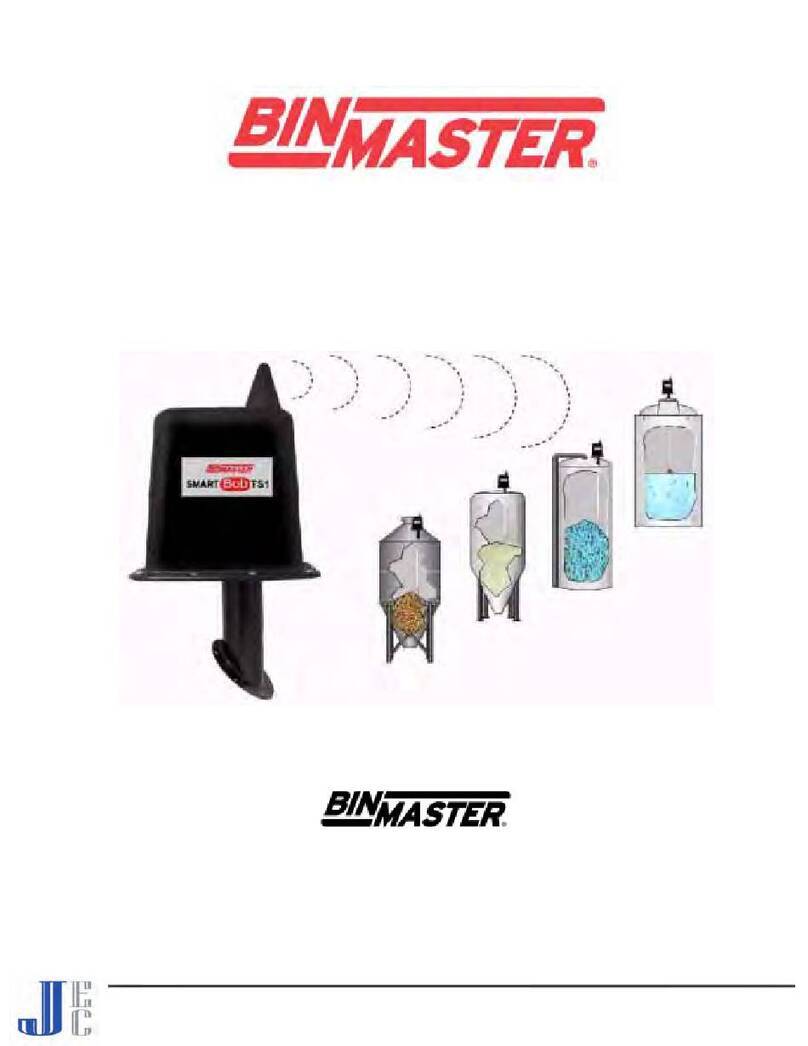
Bin Master
Bin Master SMARTBOB TS1 Installation and operating instructions
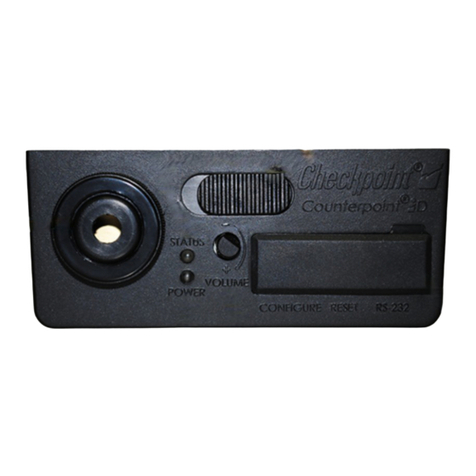
Checkpoint
Checkpoint Counterpoint iD quick start guide
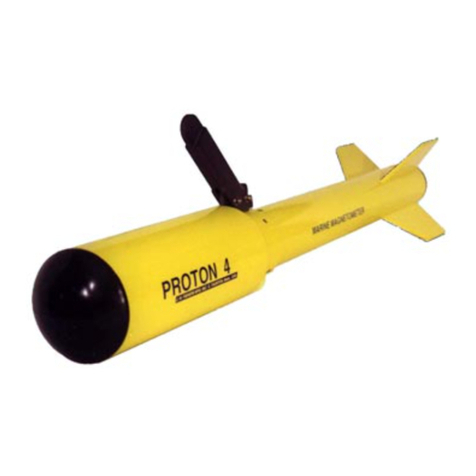
JW Fishers
JW Fishers PROTON 4 Operation and maintenance manual
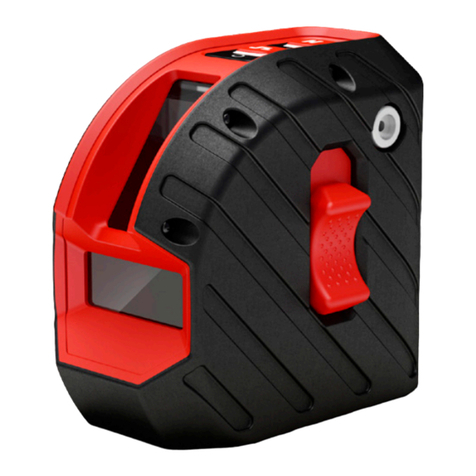
A/DA
A/DA ARMO 2D operating manual
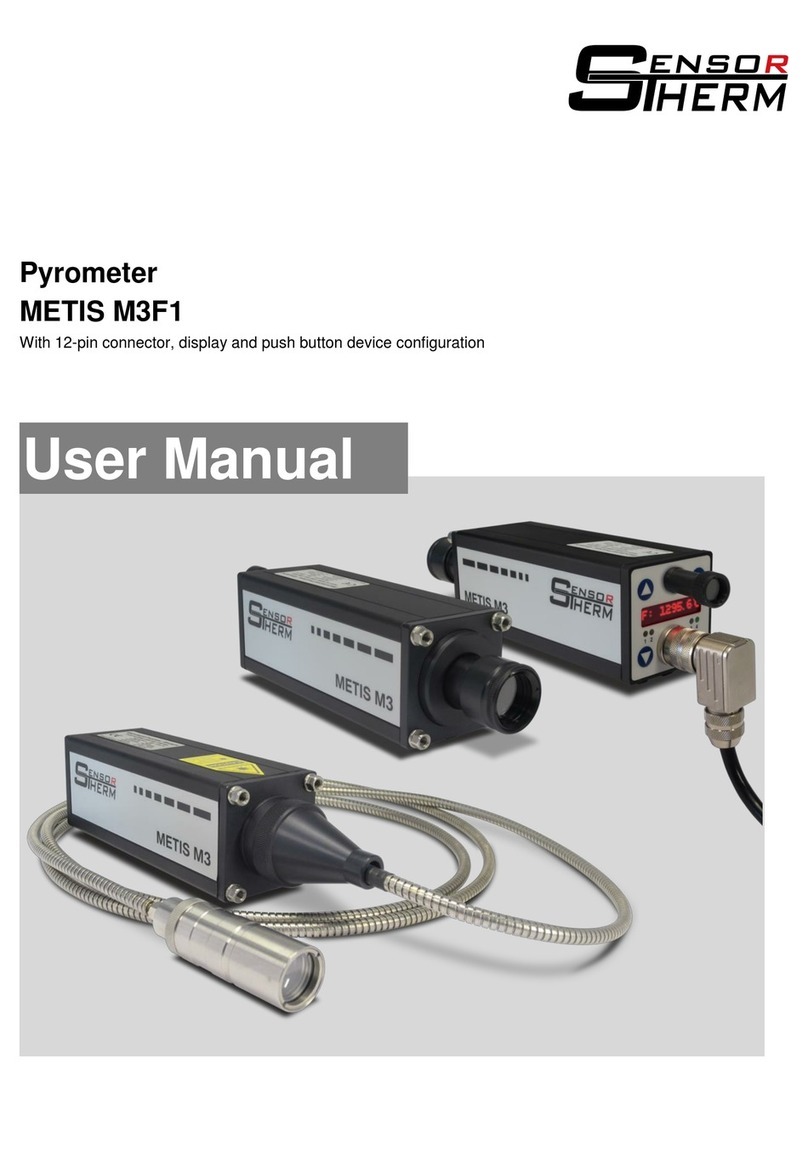
Sensor Therm
Sensor Therm METIS M3F1 user manual

Sewhacnm
Sewhacnm SI 560A user manual
